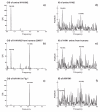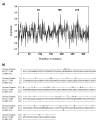Identification of hemagglutinin structural domain and polymorphisms which may modulate swine H1N1 interactions with human receptor
- PMID: 19785758
- PMCID: PMC2760557
- DOI: 10.1186/1472-6807-9-62
Identification of hemagglutinin structural domain and polymorphisms which may modulate swine H1N1 interactions with human receptor
Abstract
Background: The novel A/H1N1 influenza virus, which recently emerged in North America is most closely related to North American H1N1/N2 swine viruses. Until the beginning of 2009, North American swine H1N1/N2 viruses have only sporadically infected humans as dead-end hosts. In 2009 the A/H1N1 virus acquired the capacity to spread efficiently by human to human transmission. The novel A/H1N1 influenza virus has struck thousands of people in more than 70 countries and killed more than 140, representing a public health emergency of international concern. Here we have studied properties of hemagglutinin of A/H1N1 which may modulate virus/receptor interaction.
Results: Analyses by ISM bioinformatics platform of the HA1 protein of North American swine H1N1/N2 viruses and the new A/H1N1 showed that both groups of viruses differed in conserved characteristics that reflect a distinct propensity of these viruses to undergo a specific interaction with swine or human host proteins or receptors. Swine H1N1/N2 viruses that sporadically infected humans featured both the swine and the human interaction pattern. Substitutions F71S, T128S, E302K, M314L in HA1 of swine H1N1 viruses from North America are identified as critical for the human interaction pattern of A/H1N1 and residues D94, D196 and D274 are predicted to be "hot-spots" for polymorphisms which could increase infectivity of A/H1N1 virus. At least one of these residues has already emerged in the A/H1N1 isolates from Spain, Italy and USA. The domain 286-326 was identified to be involved in virus/receptor interaction.
Conclusion: Our results (i) contribute to better understanding of the origin of the novel A/H1N1 influenza virus, (ii) provide a tool for monitoring its molecular evolution (iii) predicts hotspots associated with enhanced infectivity in humans and (iv) identify therapeutic and diagnostic targets for prevention and treatment of A/H1N1 infection.
Figures





Similar articles
-
Comparative study of the nucleotide bias between the novel H1N1 and H5N1 subtypes of influenza A viruses using bioinformatics techniques.J Microbiol Biotechnol. 2010 Jan;20(1):63-70. J Microbiol Biotechnol. 2010. PMID: 20134234
-
Spatiotemporal Distribution and Evolution of the A/H1N1 2009 Pandemic Influenza Virus in Pigs in France from 2009 to 2017: Identification of a Potential Swine-Specific Lineage.J Virol. 2018 Nov 27;92(24):e00988-18. doi: 10.1128/JVI.00988-18. Print 2018 Dec 15. J Virol. 2018. PMID: 30258006 Free PMC article.
-
Detection and Characterization of Swine Origin Influenza A(H1N1) Pandemic 2009 Viruses in Humans following Zoonotic Transmission.J Virol. 2020 Dec 22;95(2):e01066-20. doi: 10.1128/JVI.01066-20. Print 2020 Dec 22. J Virol. 2020. PMID: 33115872 Free PMC article.
-
[Swine influenza virus: evolution mechanism and epidemic characterization--a review].Wei Sheng Wu Xue Bao. 2009 Sep;49(9):1138-45. Wei Sheng Wu Xue Bao. 2009. PMID: 20030049 Review. Chinese.
-
Diversity of influenza viruses in swine and the emergence of a novel human pandemic influenza A (H1N1).Influenza Other Respir Viruses. 2009 Sep;3(5):207-13. doi: 10.1111/j.1750-2659.2009.00096.x. Influenza Other Respir Viruses. 2009. PMID: 19768134 Free PMC article. Review.
Cited by
-
Influenza NG-34 T cell conserved epitope adjuvanted with CAF01 as a possible influenza vaccine candidate.Vet Res. 2020 Apr 20;51(1):57. doi: 10.1186/s13567-020-00770-4. Vet Res. 2020. PMID: 32312317 Free PMC article.
-
Predicted Enhanced Human Propensity of Current Avian-Like H1N1 Swine Influenza Virus from China.PLoS One. 2016 Nov 9;11(11):e0165451. doi: 10.1371/journal.pone.0165451. eCollection 2016. PLoS One. 2016. PMID: 27828989 Free PMC article.
-
Isolation of avian influenza H5N1 virus from vaccinated commercial layer flock in Egypt.Virol J. 2012 Nov 27;9:294. doi: 10.1186/1743-422X-9-294. Virol J. 2012. PMID: 23185975 Free PMC article.
-
Computational study of interdependence between hemagglutinin and neuraminidase of pandemic 2009 H1N1.IEEE Trans Nanobioscience. 2015 Mar;14(2):157-66. doi: 10.1109/TNB.2015.2406992. Epub 2015 Mar 2. IEEE Trans Nanobioscience. 2015. PMID: 25751873 Free PMC article.
-
MSCA: a spectral comparison algorithm between time series to identify protein-protein interactions.BMC Bioinformatics. 2015 May 13;16:152. doi: 10.1186/s12859-015-0599-8. BMC Bioinformatics. 2015. PMID: 25963052 Free PMC article.
References
-
- Thompson RL, Sande MA, Wenzel RP, Hoke CH, Jr, Gwaltney JM., Jr Swine-influenza infection in civilians: report of two cases. N Engl J Med. 1976;295:714–715. - PubMed
Publication types
MeSH terms
Substances
LinkOut - more resources
Full Text Sources
Other Literature Sources
Research Materials

